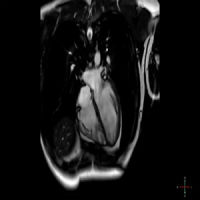Spanish and US researchers have discovered that the transition to calcium alternans, an arrhythmia associated with increased risk of sudden death, has common features with the magnetic ordering of metals. The new finding, reported in the journal Physical Review Letters, boosts our understanding of the physical causes of sudden death and paves the way for the development of drugs to prevent it.
Heart diseases are a major cause of death in developed countries. Sudden cardiac death, which involves a sudden loss of heart function, accounts for approximately 10 percent of natural deaths, most of which are due to ventricular fibrillation (an uncoordinated contraction of the heart).
One possible trigger of ventricular fibrillation is a cardiac arrhythmia known as alternans, in which the contraction is coordinated on each beat but there is a beat-to-beat alternation in the strength of contraction.
Scientist Enrique Álvarez Lacalle Blas Echebarria, Department of Applied Physics of the Universitat Politècnica de Catalunya (UPC), and researchers from California State University have shown through simulation models that the alternation is due to a type of transition that has intrigued physicists for decades: an order-disorder transition originally studied to understand the loss of magnetic characteristics when the temperature rises above a threshold value.
A Breakthrough for Developing New Drugs
A ferromagnetic material is formed by small magnets that can focus in one direction or another. If each of these magnets points in a different direction (ie, if the system is disordered), its magnetic effect is lost, the researchers explain. However, below a certain temperature, all the magnets begin to focus in the same direction and the system is ordered. This makes the whole material behave like a large magnet.
In the case of the heart, the researchers note, each subunit within the cell responsible for releasing calcium may decide whether or not to do so. When this happens in a disordered way, the number of cells releasing and not releasing is the same and the total calcium release is always the same.
However, in some situations there is a transition to an ordered state, as in ferromagnetic materials. In this state, all the cells decide to release or not release calcium at the same time, resulting in a sequence of strong and weak contractions and ultimately a transition to ventricular fibrillation. The conclusion seems to be that order can be fatal in some cases.
A better understanding of the transition that causes sudden death can help design drugs to prevent it. The findings open the door to the study of possible applications.
"We are currently studying whether the same effect is observed in atrial cells," says Blas Echebarria. "This would advance our understanding of atrial fibrillation, which does not cause sudden death as ventricular fibrillation does, but it involves a high risk of stroke and has a very high prevalence, especially in people over 60 years, reducing their quality of life”.
Source: Universitat Politècnica de Catalunya
Image Credit: Wikimedia Commons
Heart diseases are a major cause of death in developed countries. Sudden cardiac death, which involves a sudden loss of heart function, accounts for approximately 10 percent of natural deaths, most of which are due to ventricular fibrillation (an uncoordinated contraction of the heart).
One possible trigger of ventricular fibrillation is a cardiac arrhythmia known as alternans, in which the contraction is coordinated on each beat but there is a beat-to-beat alternation in the strength of contraction.
Scientist Enrique Álvarez Lacalle Blas Echebarria, Department of Applied Physics of the Universitat Politècnica de Catalunya (UPC), and researchers from California State University have shown through simulation models that the alternation is due to a type of transition that has intrigued physicists for decades: an order-disorder transition originally studied to understand the loss of magnetic characteristics when the temperature rises above a threshold value.
A Breakthrough for Developing New Drugs
A ferromagnetic material is formed by small magnets that can focus in one direction or another. If each of these magnets points in a different direction (ie, if the system is disordered), its magnetic effect is lost, the researchers explain. However, below a certain temperature, all the magnets begin to focus in the same direction and the system is ordered. This makes the whole material behave like a large magnet.
In the case of the heart, the researchers note, each subunit within the cell responsible for releasing calcium may decide whether or not to do so. When this happens in a disordered way, the number of cells releasing and not releasing is the same and the total calcium release is always the same.
However, in some situations there is a transition to an ordered state, as in ferromagnetic materials. In this state, all the cells decide to release or not release calcium at the same time, resulting in a sequence of strong and weak contractions and ultimately a transition to ventricular fibrillation. The conclusion seems to be that order can be fatal in some cases.
A better understanding of the transition that causes sudden death can help design drugs to prevent it. The findings open the door to the study of possible applications.
"We are currently studying whether the same effect is observed in atrial cells," says Blas Echebarria. "This would advance our understanding of atrial fibrillation, which does not cause sudden death as ventricular fibrillation does, but it involves a high risk of stroke and has a very high prevalence, especially in people over 60 years, reducing their quality of life”.
Source: Universitat Politècnica de Catalunya
Image Credit: Wikimedia Commons
Latest Articles
Arrhythmia, atrial fibrillation, sudden cardiac death, calcium alternans, ventricular fibrillation
Spanish and US researchers have discovered that the transition to calcium alternans, an arrhythmia associated with increased risk of sudden death, has comm...



























